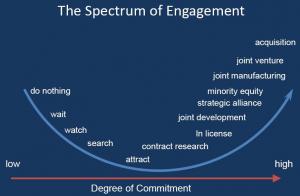
When a large, well-established organization determines that it cannot internally provide the level or speed of innovation and new product development that it needs to survive and grow, it will often engage a small innovative start-up company to make up for the shortcoming. In the NSF Small Business Innovation Showcase session, John Tao of O-Innovation Advisors, LLC, discussed the benefits and pitfalls of such open innovation approaches to R&D.
Engagement


When faced with a need for change and innovation, all organizations respond across a continuum of actions indicative of their level of engagement. At the low end, there is the "do nothing" response, and the ostrich metaphor is often used. If or when action is taken, it is often using external technology and resources to supplement their internal R & D and commercilization efforts. This "open innovation," as it is termed, can take many forms and extents, including:
- Sponsored R & D (contract research)
- Technical consortia
- Joint development, joint manufacturing, or joint ventures
- Strategic alliances
- Licensing
Eventually, such working arrangements may result in actual acquisition of the smaller firm. In order for open innovation to be effective, the working relationships, goals, and objectives need to be well thought out and well documented.
An open innovation model
The main goal of open innovation is the maximization of value creation and extraction. The process can be thought of as a funnel or, more kinetically, a cyclone. Both internal and external technology meet up with business needs (and money!) in the larger "entrance" of the cone, and commercial products and services are the result at the "exit."

Along the way, open innovation allows additional and opportunistic inputs and outputs. Inputs might occur via new licensing (in), acquisitions and "spin-ons." At the same time, the corporation may decide it appropriate to "eject" technology in the form of divestitures, licensing (out) and spin-offs. The small company brings an innovative spirit, a risk-taking mentality, speed and often a disruptive technology to the table. The large corporation brings capital, channels to market, well-developed supply chains, engineering expertise and an established sales and marketing organization.
Procter & Gamble is an excellent example of the use of the open innovation concept. Half of all new P&G products came from outside arrangements.
Pitfalls
Some of the more typical issues to watch out for with open innovation include:
- Business model differences
- Position in the value chain
- Competitive products
- Culture and strategy variances

The most common complaint of the large organization is small firms' unjustified valuation of their own technology. The most common complaint of the small organization is lack of speed and slow decision-making by the large firm.
For further information contact John C. Tao, PhD of O-Innovation Advisors LLC.



Comments
Open Innovation as I practiced is not just technology scouting/acquisition as you described. It involves both inbound as well as outbound of innovation depending on where it brings the most value. Spiral innovation is a way of saying that innovation is not linear but it often involves a lot of churning. Sometimes two steps forward and one step back.